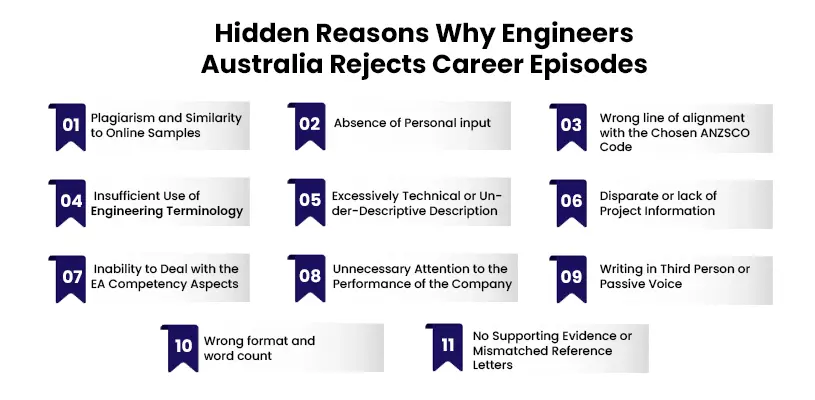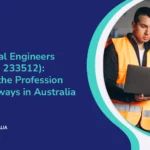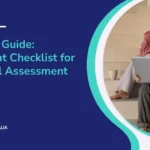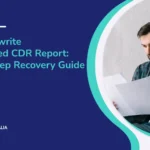
As an engineer seeking to migrate to Australia under the skilled migration programme, you must be well aware of the significance of your Competency Demonstration Report (CDR). The important part of this report is the career episodes, which are narrative essays that reflect engineering knowledge and working experience.
During this blog, we will unearth the real reasons why sometimes the career episodes that are sent by Engineers Australia (EA) may be rejected even when they seem technically viable. Recognising all these traps can help you tremendously in a successful evaluation by decreasing the possibility of rejection, delays, and even a ban.
Table of Contents
What Is a Career Episode?
An account of your task or project about an engineering work or interest. Every applicant should provide documentation of 3 career episodes, and all of them should prove certain aspects of competency about the ANZSCO occupational category they are requesting (professional engineer, engineering technologist, Engineering Associate or engineering manager).
Every career episode ought to:
- Written using the first-person tense (e.g., I was in charge of…).
- It has to be reflective of your contribution and not that of the team.
- It should be well organised into the following parts: Introduction, Background, Personal Engineering Activity, and Summary.
- Be creative and make a piece of your own.
- Nevertheless, despite these rules being adhered to, some rejections take place, and most of the time, they are caused by something that the applicants fail to consider.
Hidden Reasons Why Engineers Australia Rejects Career Episodes
1. Plagiarism and Similarity to Online Samples
Plagiarism is one of the most common covert causes of rejection of a Career Episode. To ensure that no plagiarism occurs, Engineers Australia make use of sophisticated programmes, including Turnitin, to track any duplicated material. There is a very high probability of being rejected without even being called in to interview when applicants proceed to copy and paste the contents of sample CDRs that are found on the internet, forums, or even reports by colleagues.
The content can be paraphrased but with a similar structure, thoughts, or illustrations, and still count as a plagiarism case. All career episodes are supposed to be developed with your own words as your experience. Using plagiarised material is not only a weakness of originality but also a doubt on the originality of your abilities and expertise.
2. Absence of Personal input
The Career Episodes should not portray the success of a team; they are supposed to emphasise your personal contribution to a project. One of the most common reasons is the excess use of such terms as “we” or unclear wordings that do not demonstrate exactly what you did.
Engineers Australia evaluates personal competency, and therefore, in case you are unable to clearly describe your contributions, responsibilities, and decisions of a story, it will most probably be rated as inappropriate. You have to explain activities in which you were a decision-maker or practiced engineering concepts. Without a clear idea of what it is that you are and do, there is no opportunity to measure your skills.
3. Wrong line of alignment with the Chosen ANZSCO Code
Each of the occupations in the list of Engineers Australia is linked with ANZSCO codes, which stipulate the level of competency required. Your Career Episodes might be rejected in case they present duties that are not compliant with your nominated occupation.
To take the example of a candidate seeking a position as a professional engineer (ANZSCO 2339xx), he or she should show potent engineering analysis and design work. When the value of the content is rather similar to the work of an engineering associate or a technician, the mismatch occurs. The same applies to an applicant in the Engineering Manager post where they should bring leadership and managerial responsibilities. Any mismatch between the selected code and your work experience can make your whole application come off-track.
4. Insufficient Use of Engineering Terminology
What Engineers Australia wants to find in you is the evidence you understand and know how to apply engineering principles. A lot of career episodes are discarded due to their inability to show technical language or to demonstrate complex problem-solving. Not using engineering terms by way of saying you have fixed the problem or you have worked on the project does not show your engineering knowledge.
You have to employ specialised terminologies of your profession, say mechanical, electrical, civil or software engineering. By giving some examples like AutoCAD, FEA, SCADA, or use of a Gate methodology, like DMAIC or root cause analysis, you will be more credible and meet the expectations of EA.
5. Excessively Technical or Under-Descriptive Description
It is crucial to strike the right balance between technicality and clarity. Other candidates provide career episodes full of jargon and computations and they ought to sum up their individual contribution and justification. Most do it so vaguely, skipping crucial engineering activities and steps in decision-making. Both of these are unhealthy.
The EA assessors are trained and valid engineers, of course, but they require background, not a textbook. Content in your writing should be what you did, why you did it, how you did it, and the outcome. The presentation of applied knowledge in a narrative form will assist in showcasing your technical skill and your communication ability.
6. Disparate or lack of Project Information
Another of the silent killers in assessments of career episodes is a deficiency of the basic project information. The possibility of discrepancies or incompleteness will create confusion or even suspicion about the authenticity of your application.
Additionally, you can finish each of your three career episodes by focusing on a specific task or project. Among Engineers Australia, doing duplicate work or working on two or more projects at once can be interpreted as a sign of indolence or an attempt to make the experience seem more impressive.
7. Inability to Deal with the EA Competency Aspects
The Career Episode has to showcase numerous competency elements of the booklet titled Migration Skills Assessment presented by Engineers Australia. They include the areas of problem solving, design and development, teamwork, safety aspects and communications. Unless your episodes clearly indicate those competencies, your report will not meet the expectations of EA.
Most of the applicants will only do technical work without demonstrating the whole set of abilities that are required to be a professional engineer. A properly organised CE will mention at least 6-8 key competencies, which will directly match your experience with EA evaluation categories.
8. Unnecessary Attention to the Performance of the Company
The second mistake is to point out the accomplishments of your company instead of your contribution to it. In giving a project-based application, candidates tend to explain how the project contributed in the success of the business, yet leave out the contributions that they brought on board. It is not your employer being assessed by Engineers Australia, but it is you.
Your mentioning the fact that the company made more profits does not count unless you had a personal input in it. Rather, describe the value you contributed to your engineering decisions, innovation or leadership that you can measure. Ensure that the focus remains on personal performance rather than on the reputation of the organisation.
9. Writing in Third Person or Passive Voice
The first-person active voice should be used in writing out career episodes. This is important since EA does not need a formal report; what they are looking for is a personal account. Speaking in the third person, such as “The engineer was able to design,” etc., makes you say nothing and keeps you distant.
Passive forms like The task was done, but it is not clear regarding the person who did something. You can say directly the work was done by you, take statements such as I designed,” “I implemented,” or “I managed.” It forms a persuasive and lucid account based on your job and duties.
10. Wrong format and word count
The Career Episodes are given certain guidelines for formatting and structure through Engineers Australia. Failure to consider them may lead to rejection or resubmission. Every CE is expected to abide by the four sections: Introduction, Background, Personal Engineering Activity, and Summary. Also, the career episodes that you should provide should be 1000 to 2500 words.
Using something that is too short or is too heavy, or not that does not have a logical flow, can imply bad communication or disrespect for the needs of EA. Properly formatted CE simplifies job of an assessor and demonstrates professionalism.
11. No Supporting Evidence or Mismatched Reference Letters
Verifiable evidence is needed to support a career episode (i.e., an employment reference letter). When what is on your Career Episode-such as dates of projects, job title and specific responsibilities not correlate to the reference letter or the resume, it creates doubts about your experience.
Engineers Australia is very keen on supporting documents. Even accidental misfits will lead your report to be refused. Make your documents consistent and truthful to circumvent credibility trouble.
What are the tips to make a strong career episode?
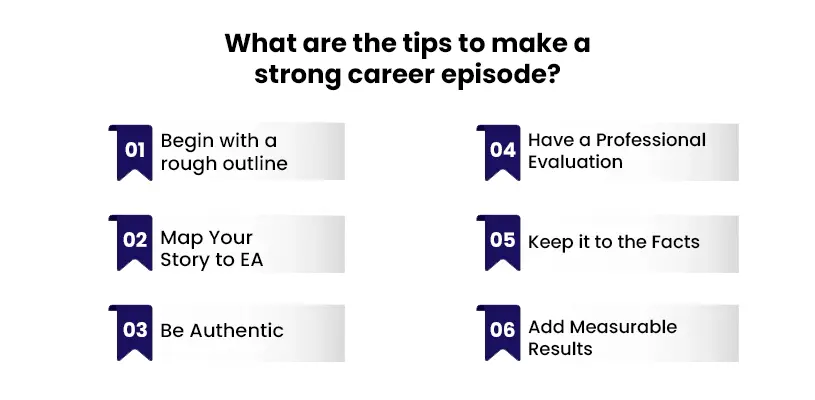
The tips to make a strong career episode are as follows:
1. Begin with a rough outline
It is important that you create an outline first before you start writing your career episode. This will keep you organised and you will not leave out the necessary structure to your episode, which is to include an introduction, background, Personal Engineering Activity and summary. The introduction should give a brief account of your role, the project, the project and the duration of the project.
The section of personal engineering is the central part in which you explain your work, choices, and technical input. The reflection is a summary of the results and competencies shown. The writing process becomes easier by presenting an outline, and the possibility of omissions is less.
2. Map Your Story to EA Competencies
Engineers Australia evaluates candidates according to certain elements of competencies as stipulated in the Migration Skills Assessment Booklet. The areas include problem-solving, engineering knowledge application, ethical behaviour and communication. You need to cross-reference your own story with these and plan and write your career episode directly in terms of these competencies.
As an example, one of the competencies may involve illustrating the ability to plan a project, in which case, have a section with a description of how you planned out the work, resources, or managed deadlines. The mapping process of your content will make your career episode fit the criteria of the assessment defined by EA.
3. Be Authentic
The issue of authenticity is essential in writing your Career Episode. Do not make an effort to exaggerate or tell something you did not do. Do not cut and paste from the internet, sample reports or even peers, as it will result in disapproval or a plagiarism fine.
Rather, tell the truth about what you have added, hurdles you have overcome, and what you have learned. Real information will not only create authority; it will make your application different and powerful.
4. Have a Professional Evaluation
Even a strong engineer can be helped through the review of an expert. The review of your Career Episode by a migration consultant, CDR professional, or other person well-known with the requirements of EA can be of great importance. A professional review helps check that your story is technically fit, addresses the standards of competencies, and has a format.
Reviewers have the possibility to find improprieties, propose to use more suitable wording, and make sure that your role stands out. This will enhance transparency, validity and adherence and give you a better opportunity of having a positive outcome.
5. Keep it to the Facts
Career episodes should be concrete. Keep the facts; tell about the instruments you utilised, the techniques you employed, the schedules, and the quantifiable outcomes. Avoid being fluffy, ambiguous or too exaggerated when structuring the story. Your career episode must sound like an obvious technical report, though, with a narrative format that introduces the reader to the paper.
Incorporate specific names of the projects, names of companies, and positions of jobs. It is also important that you describe actual engineering problems you faced and how you solved them using technical logic to illustrate your critical thinking skills as well as enhance your credibility.
6. Add Measurable Results
This is one of the best impressions you can give to Engineers Australia to convince them about how your work has made a difference through measurable outcomes. As an example, you could say that your design decreased production time by 15 per cent, saved costs by 20,000 or improved the efficiency of the system by 10 per cent.
The tangibility of your work in the form of measurable achievements also demonstrates that your engineering input had actual value. As soon as direct numbers are absent, resort to particular qualitative results (e.g., increased safety adherence, no more system failures) that will indicate success. This enables the assessor to realise the importance of what you do.
Conclusion
It is discouraging when you get a rejection letter from Engineers Australia after you submit your career episodes. Then the dream of study, career, and migration preparation comes after all the years, and it seems to be a big mistake only because of a simple email.
Nevertheless, we should not forget that the majority of rejections are not as a result of you being ineligible or lacking in expertise in the field of engineering, but rather as a result of your application failing to demonstrate to Engineers Australia that you are somebody who can satisfactorily add value.
The fact that most applicants do not know that their CDR must be detailed, structured, tailored and personalised is what makes these reasons to be hidden ones. Engineers Australia does not simply want to see that you were in a technical profession, but they want direct confirmation that you have the skills, the problem-solving solving and the ethical discernment that are desired of a competent professional engineer in Australia.
The main problem is that a lot of well-justified applications end up rejected just because of copied texts, inability to identify personal tasks, or mismatching with the ANZSCO code. In some other instances, applicants forget to include appropriate engineering terms, omit quantifiable results, and do not emphasise key competencies, which EA requires in each report. Such tiny yet important mistakes can be very expensive.
FAQs
1. How to write a career episode for Engineers Australia?
To write the Career Episode at Engineers Australia, please describe an engineering project that you have worked on and in which you had a central role, using the following format: Introduction, Background, Personal Engineering Activity and Summary. Make it personal, employ technical terminology and conform to the competency standards of EA.
2. Is it easy to get a job in Australia as an engineer?
To work as an engineer in Australia is not easy but competitive. Your prospects are better when you have a recognisable qualification, are good in English and have been favourably rated by Engineers Australia.
3. Is it easy to get a job in Australia as an engineer?
Engineers with qualifications that are recognised in Australia, with good English and with skills that are in demand in Australia have a better chance of getting a job in Australia.
